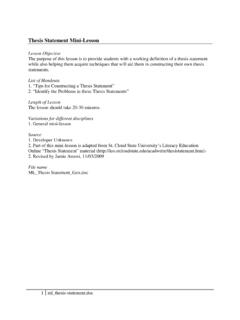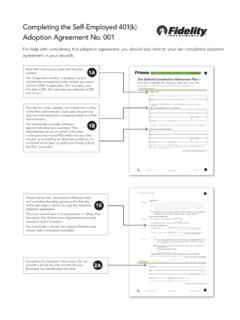Transcription of Functional Behavior Assessment (FBA) - ed
1 Functional Behavior Assessment (FBA). Functional Behavior Assessment (FBA). ---EBP Brief Packet--- Components of the EBP Brief Packet . This overview brief will support your use of the evidence- based practice: Functional Behavior Assessment . 8. Sam, A., & AFIRM Team. (2015). Functional Behavior Assessment . Chapel Hill, NC: National Professional Development Center on Autism Spectrum Disorder, FPG Child Development Center, University of North Carolina. Retrieved For more from information visit: Functional Behavior Assessment National Professional Development Center on ASD 2016 1. 1 of 31. Functional Behavior Assessment (FBA). What is Functional Behavior Assessment ? At times, all children and youth can struggle with challenging Behavior . If a challenging Behavior interferes with the learner's ability to learn, then a Functional Behavior Assessment (FBA) is needed.
2 FBA can be used when the intensity, duration, or type of interfering Behavior creates safety concerns or impacts a child's development. An FBA assists the IEP team in understanding the function or purpose of a specific interfering Behavior . Data collection is an essential component of FBA. Evidence-base Based upon the recent review, Functional Behavior Assessment meets the evidence-based practice criteria set by NPDC with 10 single case design studies. The practice has been effective with learners in early intervention (0-2 years) to high school (15-22 years). Evidence-based practices (EBP) and studies included in the 2014 EBP report detailed how FBA can be used effectively to address: academic, adaptive, Behavior , communication, and school readiness outcomes. How is FBA Being Used? Functional Behavior Assessment can be used by a variety of professionals, including teachers, special educators, therapists, paraprofessionals, and early interventionists in educational and community-based environments.
3 For more information visit: Functional Behavior Assessment National Professional Development Center on ASD 2016 2. 2 of 31. Functional Behavior Assessment (FBA). ---Evidence-base for Functional Behavior Assessment --- The National Professional Development Center on ASD has adopted the following criteria to determine if a practice is evidence-based. The EBP Report provides more information about the review process (Wong et al., 2014). Efficacy must be established through high quality, peer-reviewed research in scientific journals using: randomized or quasi-experimental design studies (two high quality experimental or quasi- experimental group design studies), single-subject design studies (three different investigators or research groups must have conducted five high quality single subject design studies), or combination of evidence [one high quality randomized or quasi-experimental group design study and three high quality single subject design studies conducted by at least three different investigators or research groups (across the group and single subject design studies)].
4 --OVERVIEW-- Functional Behavior Assessment is used to understand the function or purpose of a specific interfering Behavior . Functional Behavior Assessment meets the evidence-based practice criteria with 10 single case design studies. The practice has been effective with learners in early intervention (0-2 years) to high school (15-22 years). Studies included in the 2014 EBP report detailed how Functional Behavior Assessment can be used effectively to address: academic, adaptive, Behavior , communication, and school readiness outcomes. In the table below, the outcomes identified by the evidence base are shown by age of participants. Early Intervention Preschool Elementary Middle High (0-2) (3-5) (6-11) (12-14) (15-22). Communication Behavior Behavior Behavior Behavior Behavior School-Readiness School-Readiness School-Readiness Adaptive Academic Academic Functional Behavior Assessment National Professional Development Center on ASD 2015 1 3 of 31.
5 Functional Behavior Assessment (FBA). Early intervention (0-2 Years). * Dunlap, G., & Fox, L. (1999). A demonstration of behavioral support for young children with autism. Journal of Positive Behavior Interventions, 1(2), 77-87. doi: Preschool (3-5 years). Blair, K. C., Lee, I., Cho, S., & Dunlap, G. (2011). Positive Behavior support through family-school collaboration for young children with autism. Topics in Early Childhood Special Education, 31, 22-36. doi: * Dunlap, G., & Fox, L. (1999). A demonstration of behavioral support for young children with autism. Journal of Positive Behavior Interventions, 1(2), 77-87. doi: * Kodak, T., Fisher, W. W., Clements, A., Paden, A. R., & Dickes, N. R. (2011). Functional Assessment of instructional variables: Linking Assessment and treatment. Research in Autism Spectrum Disorders, 5(3), 1059-1077.
6 Doi: Lucyshyn, J. M., Albin, R. W., Horner, R. H., Mann, J. C., Mann, J. A., & Wadsworth, G. (2007). Family implementation of positive Behavior support for a child with autism: Longitudinal, single-case, experimental, and descriptive replication and extension. Journal of Positive Behavior Interventions, 9, 131-150. doi: Elementary (6-11 years). Blair, K. S. C., Umbreit, J., Dunlap, G., & Jung, G. (2007). Promoting inclusion and peer participation through Assessment - based intervention. Topics in Early Childhood Special Education, 27(3), 134-147. doi: Devlin, S., Leader, G., & Healy, O. (2009). Comparison of behavioral intervention and sensory-integration therapy in the treatment of self-injurious Behavior . Research in Autism Spectrum Disorders, 3(1), 223-231. doi: * Kodak, T., Fisher, W. W., Clements, A.
7 , Paden, A. R., & Dickes, N. R. (2011). Functional Assessment of instructional variables: Linking Assessment and treatment. Research in Autism Spectrum Disorders, 5(3), 1059-1077. doi: McComas, J., Hoch, H., Paone, D., & El Roy, D. (2000). Escape Behavior during academic tasks: A preliminary analysis of idiosyncratic establishing operations. Journal of Applied Behavior Analysis, 33(4), 479-493. doi: 479. Roberts-Gwinn, M. M., Luiten, L., Derby, K. M., Johnson, T. A., & Weber, K. (2001). Identification of competing reinforcers for Behavior maintained by automatic reinforcement. Journal of Positive Behavior Interventions, 3(2), 83-87. doi: Middle (12-14 years). Clarke, S., Worcester, J., Dunlap, G., Murray, M., & Bradley-Klug, K. (2002). Using multiple measures to evaluate positive Behavior support: A case example.
8 Journal of Positive Behavior Interventions, 4(3), 131-145. doi: High (15-22 years). O'Reilly, M. F., Edrisinha, C., Sigafoos, J., Lancioni, G., & Andrews, A. (2006). Isolating the evocative and abative effects of an establishing operation on challenging Behavior . Behavioral Interventions, 21(3), 195-204. doi: * Research which included participants in multiple age ranges. Functional Behavior Assessment National Professional Development Center on ASD 2015 2 4 of 31. Functional Behavior Assessment (FBA). ---Step-by-Step Guide--- BEFORE YOU START . Each of the following points is important to address so that you can be sure the selected EBP. This practice guide is likely to address the learning needs of your outlines how to plan student. for, use, and monitor the practice of Have you found out more information about.
9 ? Functional behavioral Assessment . Identified the Behavior . Keep in mind that Collected baseline data through direct FBA can be used to observation . decrease inappropriate Established a goal or outcome that clearly behaviors and states when the Behavior will occur, increase appropriate what the target skill is, and how the behaviors. team will know when the skill is mastered . If the answer to any of these is no, review the process of how to select an EBP. For more information visit: Functional Behavior Assessment National Professional Development Center on ASD 2015 1. 5 of 31. Now you are ready to start . Step 1: FBA Planning The planning step explains initial steps and considerations involved to prepare for and develop an FBA for a learner. Identify one person as the FBA coordinator who will coordinate and manage data collection, answer questions from other team members, and make sure that the FBA is implemented as intended.
10 Establish a multidisciplinary team Planning should begin with forming a multidisciplinary team that includes all individuals who have observed the learner exhibiting the interfering Behavior . Identify and define interfering Behavior Together, the team identifies the interfering Behavior that is most problematic for the learner. Any behaviors that create safety concerns for the learner or others should be addressed first. Review records of learner In order to understand the selected interfering Behavior , records should be reviewed (medical records, psychological evaluations, educational testing, Individualized Education Program (IEP) or Individual Family Service Plan (IFSP), incident reports, anecdotal notes, etc.). Select Assessment procedures Team members will gather information concerning the Behavior from formal/informal interviews and standardized Behavior rating scales.











